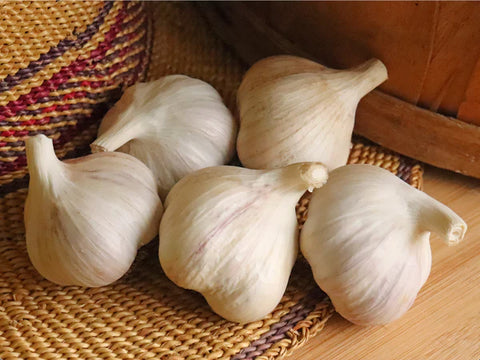As one of the most popular seasonings (or for just simply roasting and eating whole, for all you garlic lovers out there!)We believe that garlic should be an essential crop in every garden.
Garlic has a rich history and, according to much historical evidence, has been cultivated by humans for over 5,000 years. Although it is believed to have originated in Central Asia, through the ages, garlic has gained popularity and has become a staple in many cuisines around the world. Get to know garlic better by growing it yourself!

Pictured: Vietnamese Red Garlic (click for seeds)
🧄 Why Grow Garlic?
There are lots of reasons to grow garlic. It’s easy to grow and good for you! Here are just a few other reasons:
- Garlic is medicinal and full of nutrients.
- By growing your own garlic, you can try more varieties and taste more interesting garlic varieties than the garlic found in stores.
- Grow your own hardneck types, and you also get yummy garlic scapes to eat!
- It’s versatile and is used in many cuisines around the world. Garlic can inspire you to get creative in the kitchen!
- It’s super easy to save seeds from so that you can keep growing garlic year after year.
 Pictured: Amish Rocambole Garlic (click for seeds)
Pictured: Amish Rocambole Garlic (click for seeds)
Types of Garlic
Hardneck varieties can be identified by their stiff stem. They are celebrated for their large cloves and intricate flavors, but you will want to eat them first because they don’t store long into the winter like softneck types. The hard stem will become “garlic scapes,” which are typically removed and used in the kitchen. With their mild garlic flavor we love to freeze them and use them in stir-fries or as a main ingredient in pesto.
Softneck varieties of garlic develop a more pliable stem. Softneck varieties tend to be spicier and have smaller cloves than hardneck types, but they generally last longer in storage and are a little easier to grow. These are best for making garlic braids.
Elephant Garlic is not technically garlic, but it is true to its name - bulbs can weigh up to 1 pound apiece. Elephant Garlic is a different plant species than garlic - it is more closely related to leek, which is why it has a much milder (some would say boring) flavor than true garlic (hard/softneck types). But, even so, you still grow and use it like garlic.

Pictured: Amish Rocambole Garlic (click for seeds)
Planting Garlic
Plant cloves as garlic rarely makes true “seeds”. Garlic is planted in the fall, after the first light frost, but before the ground freezes, usually in late October or November. Overwintering (exposure to cold) is essential for bulb development, so container growing and indoor growing are not recommended.
To plant your garlic:
- Keep bulbs intact until you are ready to plant them, then break up into individual cloves leaving clove skins intact.
- Plant cloves about 2” deep into the soil, 6-8” apart in rows spaced 12” apart.
- The tapered end of the clove should point up, and the flatter end with the attachment point should point down.
🌿 Soil:
Garlic is a heavy feeder, so plant in fertile, well-drained soil rich in organic matter and nutrients. Covering the soil with a light layer of mulch (straw, oak leaves) helps suppress weeds, retain moisture, and fertilizes the soil. Do not remove the mulch in the spring. Cut or remove the weeds a few times in the spring and summer, as garlic does not compete well against weeds.
☀️ Light:
Plant garlic in full sun. Garlic requires direct light at least six hours per day and preferably 8 to 10 hours per day.
💧 Water:
Garlic will benefit from regular watering (at least 1” of water per week). However, do avoid excessive standing moisture in your garlic bed to prevent disease and rot issues.
Garlic in the Spring/Early Summer
Hardneck garlic will produce scapes, which are edible flowering stems that develop in early summer. Break off the scapes and use them as you would a vegetable. Breaking off the scapes will help increase your bulb yield because all the plant’s energy will go into bulb growth instead of into scape production.
When to Harvest
In North American countries, garlic is typically harvested in summer over July or August in climates that are ideal for garlic growth. In warmer climates, garlic can be harvested as early as mid-spring.
- Harvest the bulbs when the lower 4-6 leaves of the garlic plants are yellow/brown (sometime in July).
- Choose a day to harvest when the plant’s leaves are not wet from rain.
- Loosen the soil with a digging fork and carefully lift the bulb out of the soil.
- Carefully brush off excess dirt.

Curing and Storing Garlic
After carefully brushing off excess dirt from the bulbs, hang garlic or lay it out on raised screens in a well-ventilated area away from sunlight to cure for about 10-14 days. Garlic dries most quickly in areas that are dry, warm, and have plenty of airflow.
After curing, the outer skin should be crispy-dry, and the cut stem should be hard. Trim off roots and cut stems to about 1” above the bulb. Garlic is best stored at 50-70℉, at around 50% humidity.
Seed Saving Instructions
- Save the biggest bulbs for planting stock for next season.
- Keep bulbs cool, dark, and dry until ready to plant (but not in the fridge because this can make them start to sprout).
- Don’t have enough cloves to plant? You can leave scapes on plants during the summer so that they can form bulbils, which can be collected and planted like seeds.
- During the first growing season, planted bulbils will grow into single cloves, which can be dug up and re-planted to produce full bulbs the following year.
